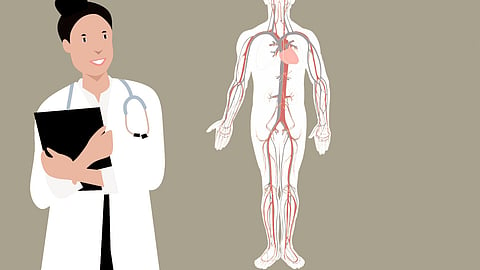

Restoring blood flow to the legs, whether through bypass surgery or a less invasive artery-opening procedure with a stent, reduced pain and improved quality of life for people with peripheral artery disease (PAD), according to preliminary, late-breaking research presented today at the American Heart Association’s Scientific Sessions 2022. The meeting, held in person in Chicago and virtually, Nov. 5-7, 2022, is a premier global exchange of the latest scientific advancements, research and evidence-based clinical practice updates in cardiovascular science.
PAD occurs when the arteries that carry blood away from the heart to the head, arms, legs and feet become narrow due to a build-up of fatty plaque. According to the American Heart Association, PAD affects more than 200 million people worldwide and causes pain, cramping or weakness in the legs and feet when walking. In 11% of people with PAD, the lack of blood flow can lead to chronic limb-threatening ischemia (CLTI) where people experience pain even when resting. Left untreated, tissue damage in the leg may result in amputation. PAD has a significant impact on a person’s health status and quality of life, such as limiting their ability to walk without pain and engage in leisure or social activities. A recent American Heart Association scientific statement on PAD quality of care reports that the negative impact of PAD on a person’s daily life “cannot be overstated.”
This is the first-ever randomized controlled trial of this scale, and it is a landmark effort in its breadth and depth,” said lead study author Matthew Menard, M.D., an associate professor of surgery at Harvard Medical School, and co-director of endovascular surgery at the Brigham and Women’s Hospital, both in Boston. “The large body of high-quality evidence that guides treatment of heart disease and stroke does not exist for PAD, and until now, there has been almost no data to inform the care of CLTI patients. Our hope is that this study may serve as a benchmark for future efforts in treating this particularly vulnerable patient population.”
A common treatment for people with high amputation risk due to PAD is leg bypass surgery, during which a passage around the blocked arteries is created using a patient’s leg vein or an artificial blood vessel. Alternatively, a less invasive approach is angioplasty with or without stenting during which a thin balloon-tipped catheter is inserted into the blockage to widen it, and a stent is placed to keep the artery open. Balloon angioplasty and stenting are also known as “endovascular” procedures.
The Best Endovascular versus Best Surgical Therapy for Patients with Chronic Limb Threatening Ischemia (BEST-CLI) Trial enrolled 1,830 people with severe PAD at 150 centers in the U.S., Canada, Italy, Finland and New Zealand. The first part of the trial compared safety, the need for repeat procedures and amputations between people who had an endovascular procedure and those who had bypass surgery. That part of the study found that people who have bypass surgery with their own leg vein as the bypass vessel had better results compared to those who had an endovascular procedure.
In this segment of the trial, BEST-CLI Trial: Quality of Life Analyses, researchers assessed the health-related quality of life for those who underwent either treatment.
To measure the health-related quality of life, researchers surveyed participants at the beginning of the study and at six follow-up visits over the four years after their surgery or procedure. The surveys asked about pain, activities of daily living, disease symptoms and severity, physical activity level and mental health (anxiety and depression). The questionnaires included in the survey were the VascuQOL for detecting changes in PAD severity; the European Quality of Life 5D to assess general quality of life, including mobility, self-care and usual activities; the Short Form 12 to assess daily living; and a numerical scale (1 – 10) to rate pain severity.
The study participants were adults aged 67 years on average, 28% were female and 72% were white. Participants included 36% who smoked cigarettes; 69% with diabetes (with and without insulin dependence); and 11% with end-stage kidney disease. About 22% reported leg pain at rest as a primary symptom.
The researchers found that quality-of-life scores were low at the beginning of the study, reflecting the notably poor health status and well-being of patients with CLTI, and pain levels were high. After surgery or an endovascular procedure, pain scores decreased substantially, and quality-of-life scores increased for all participants across all measures used for assessment.
“We anticipated low levels of quality of life at the beginning of the study due to the pain and other life-altering symptoms associated with chronic limb-threatening ischemia,” said Menard. “Improvement in health-related quality-of-life measures regardless of the type of procedure is very encouraging and highlights the importance of timely restoration of blood flow to the leg and foot.“
Menard noted there were a few differences in scores initially between the two study groups favoring endovascular repair, possibly reflecting the longer recovery time from surgical bypass, however, the differences were minor and leveled out over time.
“The quality-of-life data are a nice complement to the clinical results and suggest that both revascularization strategies may effectively improve a patient’s quality of life. So, while there is still much work to be done, and quality-of-life measures have not always been the focus in past PAD research, this is an important step forward.”
The study had some limitations including that there was little existing data to build upon. Additionally, the quality-of-life questionnaires were not all specific for vascular patients, and there were fewer female participants than expected according to the study goals, so conclusions cannot be drawn about sex differences.(SK/Newswise)
Subscribe to MedBoundtimes - An excellent medical blog for healthcare professionals
